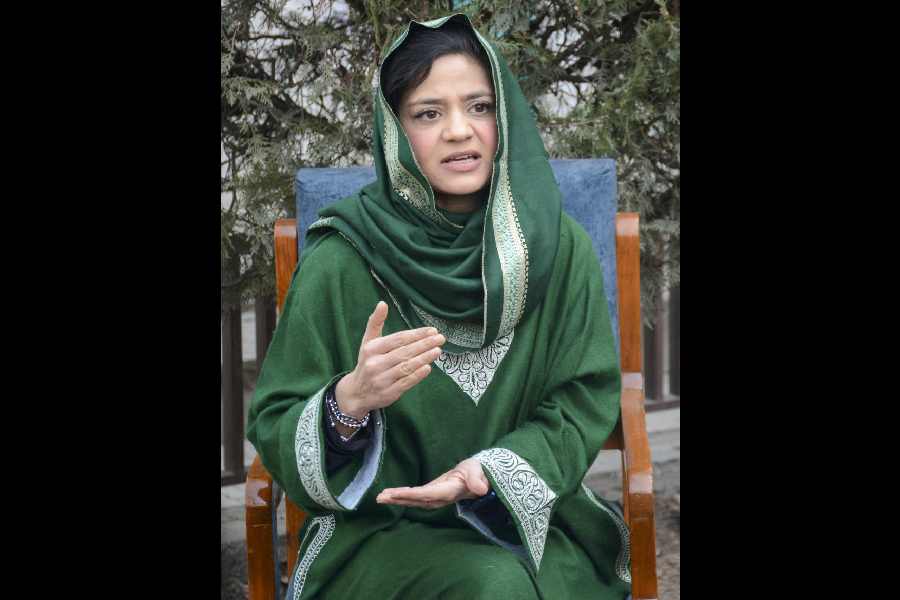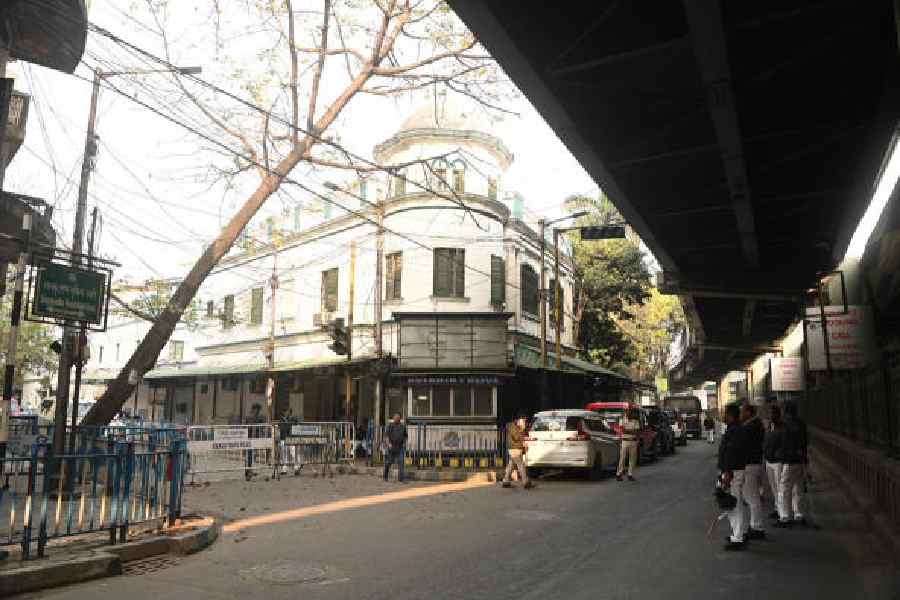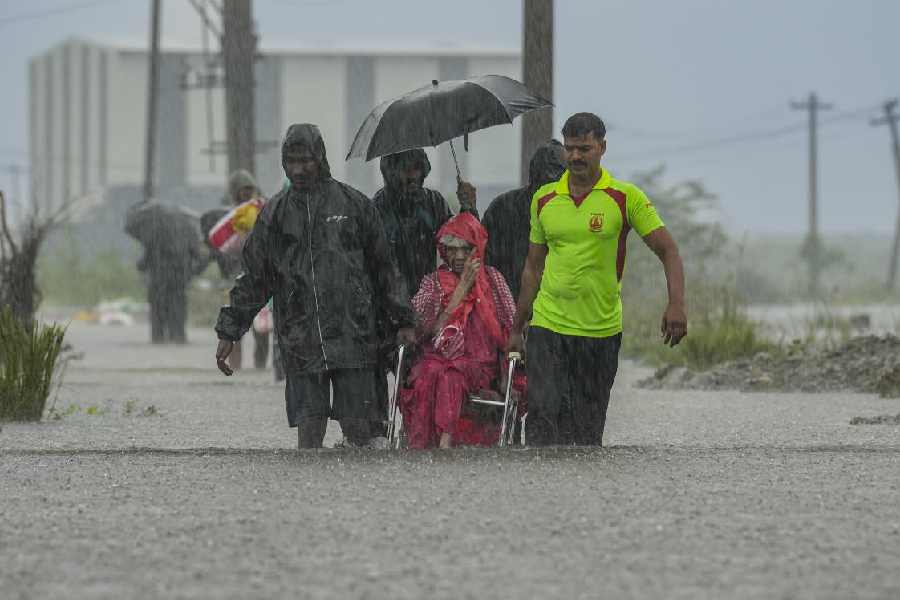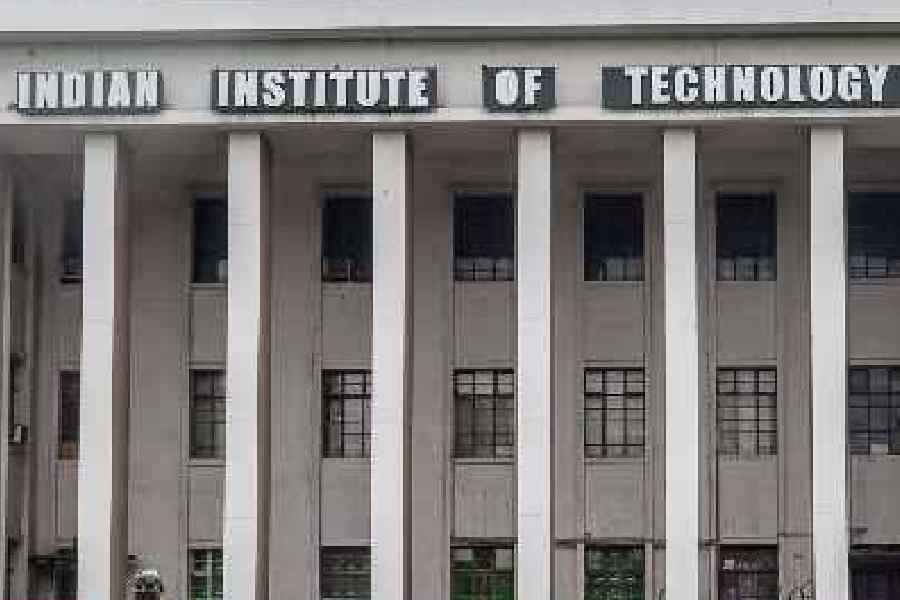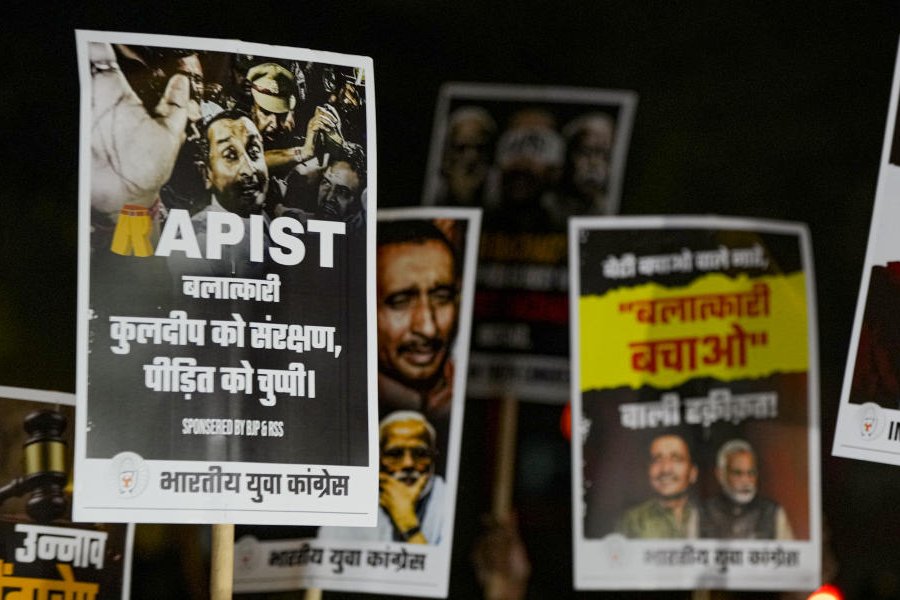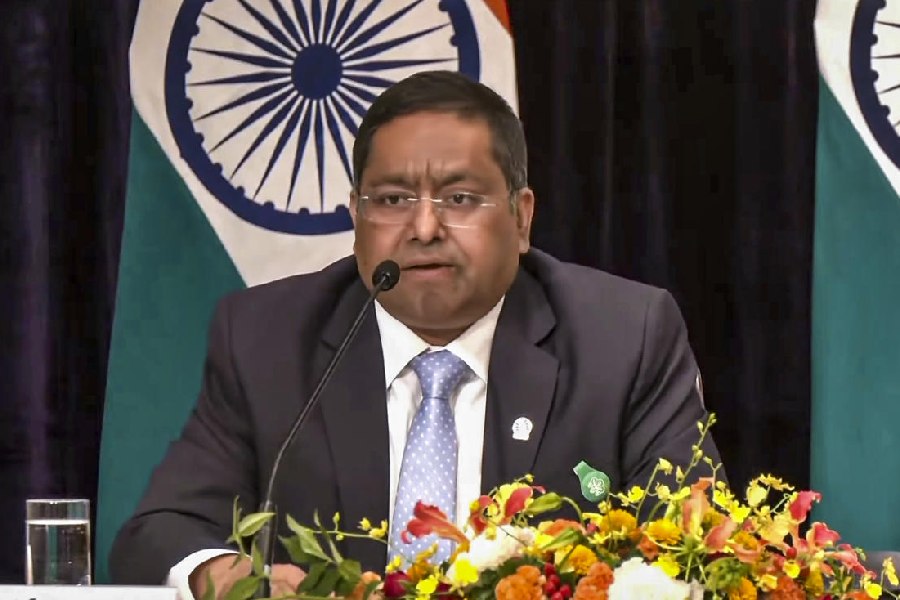 |
| Narendra Modi wipes his face while addressing the national council at the Ramlila grounds on Sunday. Picture by Ramakant Kushwaha |
New Delhi, Jan. 19: Narendra Modi today unwrapped his “Idea of India”, painting it in the seven colours of the “Indradhanush” as he sought to reach out to a rainbow coalition of social and political groupings.
Each colour supposedly signified a grouping or a concept he wanted to embed in an overarching vision he had in mind for India.
If that vision endorsed the neo-capitalist economic model adopted by most Southeast Asian countries, Modi iced it with a generous overlay of thoughts and homilies culled from the Upanishads, the Rig Veda, the Indian epics, hymns and Swami Vivekananda’s works.
For the first time since he was declared the BJP’s Prime Minister candidate, Modi laid out his outlook. He said his plans would factor in the need to integrate India’s economy more closely with the global order, be economical with legislation and doles, develop technology to acquire real-time data on exports and imports so that a parity between the current fiscal deficit and fiscal surplus could be maintained, be generous with infrastructure investments and create 100 more modern cities.
The effort to reach out to a rainbow coalition accentuated one aspect the BJP mascot had glossed over so far. For the first time, Modi was open about the fact that he was born into a backward caste family.
Last October, he had gingerly touched upon his antecedents at a public rally in Jhansi. Today, on the last day of the BJP’s national council, he used Congress leader Mani Shankar Aiyar’s “chai-wallah” jibe to underscore the “contrast” between his “under-privileged” upbringing and the entitlements of those who were to the manor born.
“The reason why they (the Congress) are running away (from announcing a candidate for Prime Minister) is because they are nurtured in a special tradition. They belong to a top-drawer family whose members lead a lifestyle where it is inconceivable for them to think of a ‘chai-wallah’ as a PM nominee. They are pedigreed, I am a humble worker. It is insulting for a member of that family to pit himself against a lowly tea-seller from an impoverished backward caste whose mother washed utensils and filled water in other’s homes,” Modi argued, to counter the Congress’s claim of being the oldest and most genuine trustee of the poor.
The Gujarat chief minister claims he once worked as a tea-stall boy.
Modi’s expatiation of his “Idea” was clearly intended as an answer to Rahul Gandhi’s Friday address that was underpinned in the “Idea of India” evolved by the Congress.
“The articulation of an Idea of India is not any one person’s ‘jagir’ (fief). It cannot be straitjacketed either,” Modi said. He rattled off 15 sayings and excerpts that ranged from “Satyamev Jayate” (truth alone triumphs) and “Aa no bhadraha krathvo yantu vishvat” (let good thoughts come from all over the universe) to “Vaishnav jana to tene kahiye, je peedh parayee jaane re” (one who is God’s true devotee, feels others’ pain) and “Naari tu Narayani” (woman, you are a veritable goddess).
Modi dressed his appeal to the east and the region’s parties — beyond Bihar the BJP has had little luck — in Hindu imagery and hard politics.
“Picture Bharat Mata (Mother India) mentally and you will see that there are things happening to the west of her. Turn to the east and the whole sector is crying for development. If you give an opportunity to the BJP (to rule at the Centre), I assure you we will put the east on a par with the rest. Our governments have had a skewed attitude towards regional aspirations because we treat them like crises. Delhi leaders see them as a burden on the Centre. To me, these aspirations present an opportunity for development,” he said, in a clear message to leaders like Mamata Banerjee and Prafulla Mahanta and others in the Northeast.
Modi conflated his east-centred message with a larger signal to the regional parties across the spectrum because some have been hostile to him on the grounds of upholding “secularism”.
“As a chief minister, I understand the importance of respect (for) our federal structure in letter and spirit. I want to transform Delhi’s attitude from a giver of funds to the states to a relationship of equality. There is no big or small brother. I believe a Prime Minister and the chief ministers can work as a team to take forward the country,” he said.
Although his rainbow concept included the family, women, farmers, youths, poor, democracy and knowledge and outlined the agenda for each target group, Modi was more expansive on his promises for urban India and industry.
Stressing the importance of integrating India’s economy more closely with the global order, he said if elected he would embark on a “Next Generation Infrastructure” programme.
The programme would focus on roads, railway (he mentioned introducing bullet trains within nine years), river-linking, a gas grid, optical fibre networks, coastal infrastructure, a 100 more modern cities with designated niche cities meant for health, sports, etc., and having more twin cities like New York-New Jersey.
He talked about an IIT and an IIM in every city, “health wellness” rather than treating diseases, and upgrading agricultural practices like using sprinklers so that “there was more crop per drop”.
BJP sources said Modi had so far been critiqued by opinion-makers for dwelling excessively on the UPA’s drawbacks and being economical with his alternative formulae. They said after today’s address — that lasted over an hour — Modi would speak more on his plan for governance.
Jaitley on tax
Amid talk in his party that income tax and some other taxes be replaced with a single tax, senior BJP leader Arun Jaitley today said such a proposal would not be easy to implement. “When we start collecting taxes at one point, it will be a challenge for the Centre to make the states understand that it will lead to increase in tax collection and their rights will not be hurt,” Jaitley said.
phew! done with today’s ADAMANTINE ONE-LINERS
Narendra Modi’s speeches are throwing up one alliterative one-liner after another — a double-edged sword that has some novelty value but runs the risk of putting semantics before substance. Drafted by some close aides who are more comfortable with English than with Hindi, Modi’s wisecracks appear to have been aimed at the Twitter and TV audience rather than the largely Hindi-speaking audience at the national council meeting on Sunday. Modi spoke in Hindi and some one-liners were in the national language but several rhyming ones were delivered in English. A sample follows:
lFive Ts for Brand India: talent, tradition, tourism, trade, technology. (‘T’ is a sensitive alphabet after Mani Shankar Aiyar made a controversial remark related to Modi’s claim that he was a tea-stall boy)
No committees, only commitment
No bills, only political will
Country doesn’t want acts, it wants action
We need to address wellness, not illness
More crop per drop (of water)
No big or small brother,Centre and states will work shoulder to shoulder
Woman was seen as a homemaker, I want to see her as nation-builder
Woh naamdaar hain, main kaamdaar hun (the Congress have a family title, I have my work to show)
Polling booth is the womb that gives birth to electoral victory, so every worker should be like a midwife


